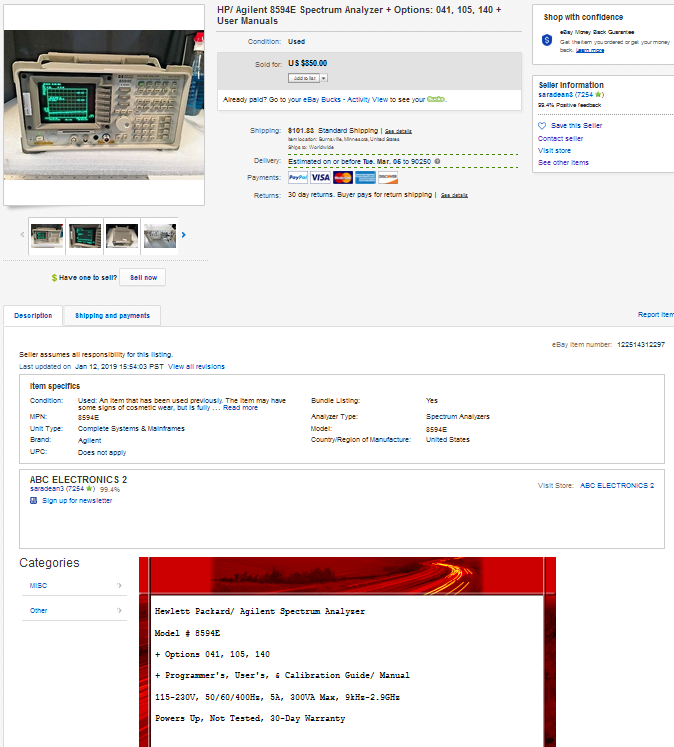 The original US ebay listing.
The original US ebay listing.While working on getting my old Apple II going, one of the diversions involved an aborted first attempt at buying a HP 8594E Spectrum Analyzer on Ebay. Then a 2nd try, ultimately successful. But which involved the worst performance by an ebay seller that I have ever experienced. So bad it's actually comical.
My life seems to have run in three phases. Up till I was 30 I was doing various things that interested me technically but didn't make a lot of money. 'Do what you like' is possible in early years when commitments are few. I'll be writing up those adventures; the Apple II articles are a lead-in to them and the plans I had for a career I wanted.
At 31, in 1987 I got married, and that was the end of all that. Switching to full time work, buying a house, raising kids, contracting, investment properties, a larger house for us, paying off multiple mortgages, part time studies, owner-builder projects... Making plenty of money but pouring all of it and all my time into family. The career path was steered by what made money, far from what I wished for.
By the late 90s an unfortunate series of events had begun and continued though the 2000s, which ushered in the third and current phase of my life. In which my time is mostly my own (good, and it's about time), yet the exceedingly odd circumstances result in a very sparse cash flow (not so good.) Eventually I'll tell this story too, but it's not possible just yet. It will be most entertaining, I assure you. Far beyond what you might assume. Quoting the police back around 2005 (who were being as helpful as they could) "We've never seen anything like this." The upside: I'm still alive, surprisingly.
Anyway, buying a relatively modern Spectrum Analyzer recently was a Christmas present to myself. Something I've wanted my whole adult life but could never spare the cash for. Which doesn't mean I didn't have the money in the past, just that there was always something higher in the commitments list. This was also supposed to be a quick thing, not taking up much time in the present. Since I'm already 'project stacked' about 10 deep.
Naturally, events laugh at my plans. So here we are, with a 'quick thing' grown complicated enough to warrant a whole article to itself. Mostly to have an online record of something really special. In the safety helmet and eating glue sense of 'special.'
 The original US ebay listing.
The original US ebay listing.
Details:
ebay item # 122514312297
HP/ Agilent 8594E Spectrum Analyzer + Options: 041, 105, 140 + User Manuals
Condition: Used: An item that has been used previously. The item may have some signs of cosmetic wear, but is fully operational and functions as intended.
Price: US $850.00 (listing price.)
Seller: saradean3 (7144 )
Aka INDUSTRIAL SURPLUS.
Quoting the seller's listing details:
+ Programmer's, User's, & Calibration Guide/ Manual
115-230V, 50/60/400Hz, 5A, 300VA Max, 9kHz-2.9GHz
Powers Up, Not Tested, 30-Day Warranty
Seller is located in Burnsville, Minnesota.
The listing had 'Make an offer' enabled, so I bargained. This exchange was all on 20190120 US date (21st in Australia.)
Shipping from Burnsville, Minnesota to my reshipper in LA California was listed as US $101.83 (UPS), so I expected to pay US $600 + $101.83. My bank account was virtually empty, but I had sufficient cash due to having just sold those lenses, plus some leftover from Christmas. I went to the bank, deposited Au$1100. Came home and went through the ebay checkout. During this there was an option for shipping via USPS priority mail, that was $91.40 ($10 cheaper and one day faster) so I chose that.
Total paid: US $600 + $91.40 = US $691.40.
My bank account statement shows (in Au dollars):
But anyway, it cost a neat Au $1000. With still the US to Australia shipping to come, and only about $100 remaining in my bank account. I was crossing my fingers that camera would sell soon. Meanwhile, the Analyzer was on its way. Apart from checking the tracking from day to day as it travelled across the US by truck, it didn't take more of my time.
But I was excited! Electronics is my love. When I started working, the very first thing I bought was an oscilloscope, second a car. My priorities are like that. Over the years I've acquired quite a lot of test gear, though all of it fairly old and second hand. A good spectrum analyzer has been at the top of my Want List for a very long time. At last!
Some of the seller's ebay listing photos, cropped and size reduced:
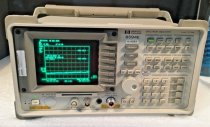 |
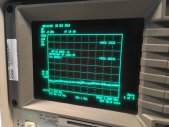 |
 |
 |
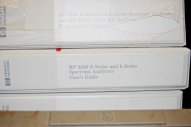 |
It appears in very clean condition, plus has these options:
They are all large, heavy and rare-ish, so buying them separately would be time consuming and expensive. They are available online for free as PDF documents, and I'd rapidly downloaded them (and many other documents related to this instrument.) But PDFs of large manuals are a massive pain to use. The PDF reader user interfaces have a long way to go. Still nothing beats being able to easily flip through physical pages. PDFs sometimes are useful for doing electronic searches, but even then just opening a real manual to the right page can't be beaten. Not to mention the whole briar thicket of crappy quality manual scans and various data compression defects.
I started an eevblog forum discussion thread on buying this. Most of that focussed on the screen messages visible in photo 2 above: "OVEN COLD" and "FREQ UNCAL". I knew the oven message was probably just due to the instrument only being turned on briefly for the photo. The 'oven' referred to is a small heated enclosure for the reference oscillator. In operation it is held at a controlled temperature for stability. It takes a little while to heat up. So that could be ignored.
The 'freq uncal' is a bit more mysterious. There are several possible explanations. One could be a missing jumper on the machine rear — but it is visibly present. Another could be that a battery responsible for maintaining calibration trim data has gone flat, losing the data. This could be a bit of a pain, but with a new battery and the Calibration Guide it's not too hard to fix. This seemed the most likely cause (but was wrong.)
Otherwise, from the display it appears the instrument is working. Seller's "not tested" is to be expected, since checking its operation comprehensively requires considerable expertise, test gear and time.
I'd had a few small items sitting in my reshipper 'mailbox', and cleared them out (sent to me) in anticipation of the spectrum analyzer big box arriving. On the 27th (Oz date) I received a very welcome email from the reshipper:
Date: Sat, 26 Jan 2019 21:16:31 From: Shipito To: -me- Subject: Shipito Package EJ received! We have received package EJ and entered it into your Shipito mailbox. PACKAGE ID : J8637-EJ SENDER : INDUSTRIAL SURPLUS WEIGHT : 55.20 lb DIMENSIONS (L x W x H) : 24.00 x 24.00 x 16.00 LOCATION : Hawthorne, CA
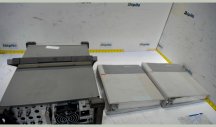 |
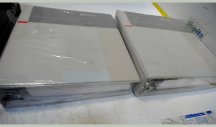 |
Spot anything else?
I was pretty busy around this time. Shipito sent those photos on the 29th (US date), which was perfect timing because just the day before (29th Oz date) I'd sold that camera, for Au $950. So could afford the US to Oz shipping.
 Here's how much that cost.
Here's how much that cost.
Total charges from Shipito: US $14.
Which I think is very reasonable. Thank you Shipito for everything you do!
Everything else on that list is annoying, because...
GST. Our glorious Oz government just last year imposed a tax on private imports, forcing large scale overseas handlers to collect their tax for them. 'Goods and Services Tax' isn't supposed to apply to second hand goods, but they imposed it on such things being imported anyway, because they can. And shipping fees are counted as a service. Never mind that it's a cost incurred outside their jurisdiction. Arseholes. And quite infuriating.
As for shipping costs, that's even worse. Some history: Up till a couple of years ago we had an Australian company called TNT (Thomas Nationwide Transport.) They were really good. Shipito handles a large bulk of goods, and had set up an online price comparison page for parcels to be shipped wherever. The package sizes and weights are a known, and you see a list of the freight quotes for that parcel, from all the carriers providing a service to where you want the parcel to go.
TNT were usually far cheaper and faster than any competition. Typically 30% cheaper, and amazingly fast. They could get something out of the Shipito warehouse (about 2Km from LA airport), straight onto a plane and to my door in Sydney Australia, in less than 2 days. As their standard service. With highly detailed tracking, and invariably careful parcel handling. Even the local van driver was hyper efficient, friendly and helpful. He'd got to know that I'm usually down the back in the workshop and would just bring parcels straight down to me there.
TNT made other carriers like Fedex look like overpriced bumbling, slowpoke and hamfisted clowns. All the time.
And so Fedex bought them out, and shut them down. There is no longer any such thing as TNT, as a Shipito option.
That's one aspect of annoying. This time, for this box, the Fedex quote was the cheapest (but not by much, and a lot more than TNT would have been) so I chose them. Then watched in amazement and shock, as Fedex repeated an unbelievable poor performance I'd seen them do once before. I had thought that must be a fluke of routing SNAFU, but no.
Back in 2013 I had a 72 lb (33 Kg) Tektronix TLA 721 Logic Analyzer to get from Shipito to Sydney. For once Fedex were a bit cheaper, so I chose them. Instead of the direct 1 mile to LA airport they first trucked it by road from LA to SanFrancisco (about 300 miles), let is sit there for a while. When it did get to Sydney they trucked it North from the airport to some depot on the far side of the city (I'm Sth of the airport, on a direct freeway from the airport.) Days later it finally turned up here. I wasn't impressed.
This time, FedEx did worse. Again they routed by road from LA to SanFrancisco. Sat there for a while before getting on a plane. Which went to Hawaii. Where it was offloaded. Sat there for a while. Once in Sydney it shunted around a couple more days before arriving here. And the box had been heavily dropped on one corner. By Fedex, since the photos at Shipito show the box in pristine condition.
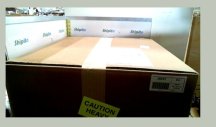 |
 |
 |
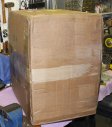 |
1,2. Box at Shipito, after UPS trucking across the USA. ie Before FedEx. Still looks like a new carton.
3,4. Box as it arrived here, after Fedex handled shipping from Los Angeles to Sydney. 'Battered box syndrome.'
This is why I insist on foam-in-place packing for large expensive items. It's the only way to be sure.
 Tracking information, from https://www.fedex.com/en-us/home.html
Tracking information, from https://www.fedex.com/en-us/home.html
The dates and times are Oz local.
20190129 I paid for mailout from Shipito.
20190205 It arrived here at 1:30pm.
About 7 days.
And the FedEx tracking page is retarded.
To establish that there really were just two manuals included in the box, here's a couple of photos of the foam-in-place blocks, pulled out of the box.
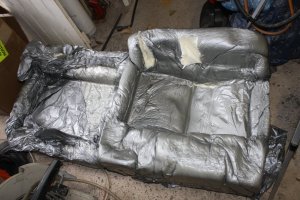 |
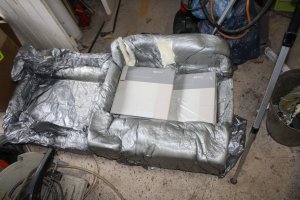 |
There was plenty of space in the box to have included the third manual, if they'd had it to hand, been competent, and wanted to include it. For instance they could have placed it against the side of the instrument. Instead they poured the foam with only two manuals inside, and the set foam does not lie. Leaving it out (deliberately or accidentally), when it was both described and photographed in the ebay listing, and the foam shows it was never present, was very stupid.
But we have barely scratched the surface of Stupid yet. Remember those photos of the manuals at Shipito?
I'd looked at those photos mainly to check for any damage. There was none, and I went back to other chores. Paid the fee to initiate onshipping. This was my second mistake. An easy one to make, sort of Stupid Lite.
I'd failed to notice there are only two manuals, not three. I realised this just after committing the box to mailout.
Sigh. I didn't want to hold it up, have Shipito open it again and tell me which two manuals are there, of the three supposed to be there. Best to get the box here asap. Also I thought it faintly possible Shipito might have missed one. Maybe it was under the bottom block of foam-in-place packing? (It wasn't.)
Dear saradean3,
Hi, The box arrived at my reshipper in CA intact, all looks good. Except one of the three manuals is missing. Your listing stated "Programmer's, User's, & Calibration Guide/ Manual" and three binders are visible in the photos. This was a big attraction for me. But at Shipito there are only two manuals according to the photos they sent me. Can you please check if one was omitted by mistake?
Guy
Unfortunately I can't make out the titles from the reshipper photos, and the box is now on its way from USA to Australia. By air, so won't take too long. I'll take photos of the box opening when it arrives, and let you know. With my luck, the missing one will be the Calibration guide, since from your screen shots, it appears the machine's backup battery is dead and it's lost cal data. (That I expected. Hence my desire to make sure I get a paper copy per the listing.) It's also possible they just didn't find the third manual, if you put it under the bottom foam-in-place. We'll see. Good thing about foam-in-place, it will definitely show whether the reshipper just lost the manual (extremely unlikely, they are very good) or it got left out originally. Thanks for your understanding.
Hello again, The HP/ Agilent 8594E Spectrum Analyzer ebay 122514312297 arrived today. The packaging did it's job, there's no shipping damage. However as shown by the reshipper photos, one of the advertised three manuals is missing. It is the User's Guide. The manuals in the box are the Programmer's and Calibration Guides. I took photos and a video of the box opening, now online here: http://everist.org/pics/HP8594e/
The foam in place has formed to fit just those two manuals, so the third wasn't lost at the reshipper.
The User's Guide title is visible in your listing photos, so it's definitely supposed to be there. I'd like to obtain this, happy to work out with you how best to do so. I'm in Sydney Australia.
Also I've had a quick play with the machine, and there are two problems: The screen sync is shakey, and it doesn't seem to be responding properly to the controls. Both of these may resolve easily, loose connections etc.
Regards,
Guy
New message to: saradean3
Hi, Yes, I'm in Sydney Australia. For US purchases I use a reshipper in CA so normally have my ebay ship address set to that. At the moment it's set to Aus, due to buying something small locally. But I don't expect you to pay the international shipping on the missing manual. (Unless you want to!) You can post it to the same address as for the 8594e. [address removed], Hawthorne, CA 90250, USA.
If you do post it direct to Aus, airmail with tracking please, I need it asap. [my home address removed.]
Btw I'm extremely pleased that the two manuals I received were both brand new, never opened from the shrinkwrap. Thanks! Crossing fingers the Users Manual is same. Please can you wrap it tightly in shrink or bubblewrap, so the block of pages can't bump around against the ring binders in transport? They can get pretty badly chewed. The two I received were fine, due to original shrinkwrap of the pages block inside the binder.
I'll make another attempt to send you the photos link, in a short message right after this. It's annoying how ebay 'filters for our protection ha ha' such information.
Hope your weather lets up. A little snow here, I WISH. It's currently mostly very hot.
All the best, Guy
New message to: saradean3
Hi, The spectrum analyzer unpacking photos are at everist full-stop org slopey-line pics anotherline HP8594e
Sorry about the obfuscation. Thanks to ebay and their determination to protect us innocents from ever being able to talk to each other directly, without big brother ebay in the middle. Btw the site front page has a working contact info.
All the best, Guy
New message to: saradean3
Hello, Is the weather still terrible? I haven't heard anything back.
Did you find the missing User Manual?
When will you be sending it?
Will you post it to my CA-USA reshipper address, or direct to me in Australia? If the latter, I'll split the cost with you if you like. Is mail even running, with all the snow?
Regards,
Guy
Aside: I was nonplussed about the lack of response. Why? I'd read online reports of severe, record-breaking snowfalls in some areas of NE USA. Wondering if they'd had some trouble like roof collapse, car accident etc, I sent an email to the group listed as a parent company to the ebay seller ABC Electronics.
I'd like to enquire whether your subsidiary ABC Electronics, aka ebay seller https://www.ebay.com.au/usr/saradean3 are still operational. Has something happened to them? Snowed under perphaps?
I ask because I bought an item from them on ebay, (Item 122514312297 HP/ Agilent 8594E Spectrum Analyzer + Options: 041, 105, 140 + User Manuals.)
It was delivered OK, but they'd left out one of the three manuals, presumably accidentally. I'm trying to obtain it.
After contacting them, this reply was the last I heard from them:
I've bought from them before, they are always professional. This silence is very uncharacteristic. I'm worried. If bad weather/snow is the problem, I'm sympathetic. You're in that area, can you tell me the situation? Are they OK?
I'm in Sydney Australia, so don't know, and can't phone to ask.
Sincerly yours,
Guy -----
Aside: I'd been considering the possibility that I might need to buy a 'replacement' on ebay for the missing user's guide. I did an ebay search for it. There are quite a few, though none of them seem to be as late an edition as the manuals I'd already received with the machine. Those are 1995 and 1997. The later the better, since it seems the unit is quite a late model.
But there was one listing of suitable manuals. Well, well. It's by the same seller, saradean3, and says they have 4 of them. Great! So the next thing I hear from them should be something like "OK, the manual is in the post to you."
New message from: saradean3 (7,221Green Star)
I have been searching every where for the manual and unfortunately I cannot find it. We have looked at all locations and I have no answer as to why it is missing. We have calibration and operator manuals for it, just not the users manual. The other manuals are more technical, do they not have the answers you seek in them? Let me know how you would like to proceed. My apologies around this whole ordeal
But what the heck is this? "The other manuals are more technical, do they not have the answers you seek in them?"
Are they saying I don't need that manual, so why am I complaining? Do they think the contents of these manuals predominantly overlap? (There's almost zero overlap.) Do they think the User's Guide, a 370 page tome, is something one can do without? That the Spectrum Analyzer can be operated by guesswork, without the manual?
I sense the Stupid is ramping up to something spectacular.
Another question: if they don't have a User's Guide, how do they know how 'technical' it is, relative to the others?
Regardless, the bottom line is it was included in the listing, they have to provide it, they have several copies (likely including the one I paid for), and I demand they provide it.
Just so you understand how large a manual this is, here's a PDF copy. (3.7MB) How'd you like to have to work with this on screen, because someone decided you didn't need the physical original volume that you'd paid for?
Also in parallel I'd been preparing to try and fix the fault(s) the machine has. We'll get to that later. But I was pretty convinced by now that the seller had known perfectly well the machine was non-functional. It's immediately apparent as soon as you press any front panel buttons. It simply does not respond. Front panel is dead.
Am I supposed to believe they turned it on for the photos, but never tried pressing any buttons? Also during start up there's a few seconds where the screen is a mess of bright shaking lines. That's obviously far from normal.
Though sometimes it does make some screen responses many seconds after a button press. This too is very odd. A strange fault. I'd started another electronics forum thread about this.
Anyway, by now it's apparent that I need to be cautious and precise in all further communications with the seller. Something is not right here.
Hi, glad to hear from you. Was getting worried. Quite the mystery.
Firstly, did you see my photos of unpacking, and the foam-in-place? The foam shape clearly proves there were only ever two manuals in the box. So does the unpacking video. I still have your packing and can take more detailed pics if you like. Point being, I have proven it was not sent, and can add that photo proof to an existing eevblog thread on repairing this instrument if this continues to drag on.
Second, you agree your listing and item photos make clear there were supposed to be three manuals, including the User's Guide? That manual specifically was in your listing pics. Which I've saved.
Third, you mention you cannot find any User's Guide for the HP 8594E. Yet you have a listing of them for sale, showing Qty:4 available. With same pub. date (1995) as the Prog. Guide I did receive. (Cal Guide is 1997.) See your ebay listing #111709366625. I'd suggest what happened is my manual somehow is there. Is it possible the packer decided the 3rd manual didn't fit in the box, then just 'put it back with the others'?
Anyway, I do insist on getting it. Somewhat annoyed about this complication, since I'll be paying for US to Australia post plus reshipper handling on this, which is significant. I have PDF copies of the manuals, but they are far less convenient than paper and have typical PDF defects. If I don't get the paper copy I paid for from you, I'll have to buy one elsewhere. And that will be a negative for you. Please send it to [my reshipper addr] Hawthorne, CA 90250 USA
The electronics forum thread is tinyurl dot com slash 8594E-repair
Regards,
Guy
New message from: saradean3 (7,226Green Star)
We are more than willing to cover the cost of you purchasing another manual and we have also been searching for one to purchase and send to you, we want to make this right. The listing you said we have up is for an 8590, if that will work we will send it straight out to Australia today.
New message to: saradean3
Ah ha! I see where the misunderstanding originates. You've been searching for an "8594E User's Guide." But I don't think such a thing exists. The missing manual, per your original listing pics of it with the unit I bought, is "HP 8590 E-series and L-series Spectrum Analyzers User's Guide". HP did just one User's manual for the whole family of machines. And that's what's shown in your current listing for the 4 you have. Exactly the same. Sorry I didn't catch that misunderstanding earlier. I had assumed you'd have looked at your own listing pics of the missing manual before hunting for it. [This] I've attached your own photo from the original listing. The User's Guide is in the center. The manual at bottom with hidden title is the Calibration Guide, which I received together with the Programmer's Guide, visible on top.
Anyway, thanks for the offer of direct postage. If you're happy to do that, many thanks (so long as it's via some fast method, with tracking.) But I'm OK with having it sent to my US reshipper, since our original deal was for US shipping.
All the best,
Guy
I have bought from you before, and always previously found you helpful and professional. I'm aware the weather there is a difficulty, and have accepted delay for that reason. But by now this is getting hard to believe. Please just post the correct manual, airmail printed material, and let me know the tracking number. So we can put this to rest.
Incidentally I'm also inclined to think that your description "Powers Up, Not Tested, 30 day warranty" was probably written in the knowledge that the unit does not respond to button presses. No recourse there since I bought on the understanding it might not work, and the shipping distance makes 'warranty' untenable. I hope to identify that fault and fix it. But it further sours my experience of this purchase and the price.
Guy
New message from: saradean3 (7,248Green Star)
We do NOT have the manual and cannot find it online to purchase for you. If you can find it we will pay for it. I don"t know what else you would like us to do.
I think it is a bit silly to spend the high amounts to have you ship it back over a manual but if you would like to return the whole unit and receive a refund please start a return request and we will get you a label.
Good grief.
My thoughts at this point, not sent to them:
They "don't have one and can't find one anywhere even online." Oh really?
And yet their own listing, for 4 of these manuals, is still up on ebay. As I've pointed out to them previously. Am I correct to guess they have forgotten that I'm aware of their listing of the 4 manuals?
Also mention of shipping the unit back (from Australia) is just waffle since it is a ridiculous idea and I've already stated that was not practical.
They are just flat out lying, and saying crap as a diversion. They have no intention of sending the manual.
I think they probably never did. They also apparently do not care if they are obviously, absurdly exposed as lying. Customer paid by debit card, cannot do a full or partial payment reversal as would be possible with paypal, so they don't g.a.f.
All right. No further point trying to discuss with them. But I do need the manual.
So today (20190223 Oz) within minutes of receiving their lying message, I bought one of their 4 listed ones.
To be sent to Shipito in CA. US $25 plus $4.31 shipping.
 Here's their listing, immediately after I bought and paid for one of the 4 identical manuals.
Here's their listing, immediately after I bought and paid for one of the 4 identical manuals.
Ebay item #111709366625.
So now they have three, of the manuals they "do NOT have".
I like this picture.
It's not often you get to simultaneously buy something that (supposedly) does not exist, and also poke a liar in the eye.
Liars are vile.
Photos from that listing. Click on #2 to read the title.
 |
 |
 |
 |
 |
If they actually send it, they are effectively selling me stolen property (ie mine.)
If I want, I can then give them two negatives. I'll write up this saga of incompetence and lies
on NobLog, then tinyURL link to it in the ebay negative comment.
As for money... what a pity I didn't use paypal to pay for the instrument. But I did use paypal
to pay for this manual.
All this delay is also holding up three items (2 other manuals related to the 8594E plus a small Tek manual) sitting at Shipito. I've been holding them there in anticipation of the 8590 E-series User Guide arriving from saradean3, so I can combine them.
I'm eager to see what happens next. It was late Friday in the USA when I purchased the manual on ebay. I won't know for at least three days whether they are going to notice who bought that manual. Will it slip through and they just post it? Or if they notice, what are they going to do? They were just stupid enough to insist they do NOT have a manual, that they currently list 4 of for sale. Are they also stupid enough to actually ship the manual they say they do not have, to the person they are insisting this to?
This is hilarious.
Of course I'm hoping they do ship it. After all I want that manual, and getting it is the primary goal.
What else I do after it's on its way, I will decide then. At very minimum I'll be puting this online, for general entertainment.
 20190227 Wed. (Oz date)
20190227 Wed. (Oz date)
Wheee! They shipped it. So much fun.
Taking any further action before it arrives at Shipito and I see photos of it, would be premature.
So this part of the tale must pause for a few days.
The next day, 20190228 Oz Thursday morning 9am there's a new message from the seller:
What address would you like the manual shipped to in Australia?
Aside: First note what is absent. Anything like "Oh hey, we found it! It had fallen down the back of something. Sorry!"
Not even mentioning whether they have found the misplaced original or another copy, says this is not genuine.
I take their message as merely a probe, to check my status. Perhaps they have finally noticed who they sold that manual to, and now are trying to pretend they really did want all along to send it for free.
But I already gave them my Australian address a few messages ago. Can they not access back messages? Of course they can. Also I said it was OK to send to my US address, which they definitely can find since it's where they posted the original box.
If they really wanted to send the manual they could simply have done it, rather than begin another message exchange and the several days delay that will result (going on their past behavior.)
I don't for a moment believe they'd actually send it if I (again) provided my address.
Anyway, too late.
email header:
Date: Wed, 27 Feb 2019 15:02:21 -0700 (GMT-07:00)
Subject: Re: guy_d sent a message about HP/ Agilent 8594E Spectrum Analyzer
+ Options: 041, 105, 140 + User Manuals #122514312297
Thanks, but no need. I gave up after you insisted you DID NOT have any, and bought one of the four you had listed. It's on its way according to the tracking. The only question now is what do we do about this:
Guy.
Aside: That's where it stands. I've held off doing anything punative for far too long. I'm going to wait just a little bit longer, to give them a chance to act to compensate me for the omitted manual, the faulty machine sold as "used, working" ebay category, the cost of the replacement manual and postage, this huge waste of my time, and the aggravation of having to deal with their obstruction and blatant lying. If they (as I expect) do nothing then it's going to be ebay-retribution time, to the maximum extent possible.
 |
 |
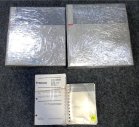 |
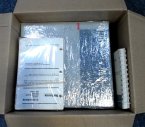 |
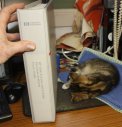 |
 |
1. What arrived at Shipito in California. Zooming the original PNG photo from Shipito, the title can be just made out. It's correct. Interestingly, it's not the one shown in the seller's listing pic. That one has a sticker on the front cover. So what year edition this one is, remains to be seen. It might even be the actual one missing from ebay item 122514312297. I can't see any matching identifying marks, unfortunately.
2. The other manuals (from other ebay sellers) are a Calibration Guide specific to my machine, a Quick Reference Guide (very useful!) and an unrelated manual for a Tektronix item. Here's the cost to consolidate the four things to one box, and post it to Australia. Adds up to about US$95. The User's guide is the largest, heaviest item, so accounts for a lot of that cost. None of this stuff is cheap.
3, 4. The items being packed for shipment. As of 7th March this parcel is on its way here.
5. It arrived 20190312. Finally, the User's Guide in my hand. Well, I'm pleased, even if everyone else slept through it.
6. In good condition too. It's a 1995 edition which is OK. Incidentally I notice that it's definitely not the actual item shown in the original listing with the spectrum analyzer. The title card in the spine pocket is longer than the one originally pictured, though the volume is identical for all practical purposes.
Category: Paid another way
Case ID: PP-D-xxxxx280
We're waiting for the seller's response. We'll get back to you by 18 March 2019 at 6:23:46 PM AEDT.
You've reported that your PayPal account was charged but you paid another way.
Case details:
Seller information ABC ELECTRONICS
Transaction amount $29.31 USD
Transaction ID 1N814xxxxxxxxx61R
Date reported 8 March 2019
Your notes
Complicated deliberate fraud case. To obtain a printed manual I had already bought and paid for by credit card (part of ebay 122514312297) but not received, deliberately omitted by seller, I had to buy it _again_ from same seller due to them lying. (Ebay item 111709366625, and paid by paypal this time.) I have a complete writup with photos online here: http://everist.org/NobLog/20190223_full_spectrum.htm#sum That is the brief summary. Scroll up on that page for the full history including all correspondence. The seller became unresponsive when I stated a refund was appropriate.
 20190313 (Oz date)
20190313 (Oz date)
Huh. Something happened. The seller sent a partial refund, on the original purchase of the spectrum analyzer.
Not a very generous one, considering the overall mess. I've no idea how they arrived at a value of US$51.40, considering a partial refund on the SA purchase (US $600 + $91.40 postage) plus full refund of $25 + $4.31 postage for the manual re-purchase.
I think I'll wait and see what Paypal have to say about it.
There's still the question of what ebay feedback I give this seller, for the original purchase and the manual 're-buy'. I'm torn between 'giving a cheat and liar what they deserve', and 'sympathy for a possibly struggling business having a hard time.'
What do you think? I'd be happy to hear other's opinions.
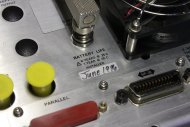 |
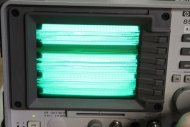 |
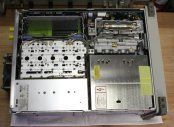 |
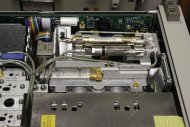 |
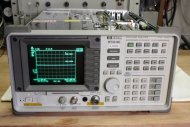 |
1. According to an original-looking label on the rear, the backup battery was installed June 1996. It's well beyond its expected lifetime, so needs to be replaced even if it isn't already flat.
2. During start-up, and whenever the green PRESET button is pressed, the screen does this for a couple of seconds. This is absolutely not normal. Plus there is the issue with the dead front panel buttons. With the very odd behaviour that sometimes after pressing any of the other buttons, several seconds later the screen will show some response (but not very sensible.)
There's definitely some work to be done, so the machine has to be opened up.
3, 4 & 5. The cover slides off to the rear, exposing the framework. There are a few empty card slots and unused RF connectors, but according to the PDF service manuals I have, these are all for other options hardware not present. It looks like everything that should be present, is.
Where is the battery anyway? Just looking at the machine, I couldn't find it. It should be on the CPU card, but where is that? The PDF Service Guide (Assembly-Level Repair) and the Schematics set I'd separately bought from Artek quickly locate it.
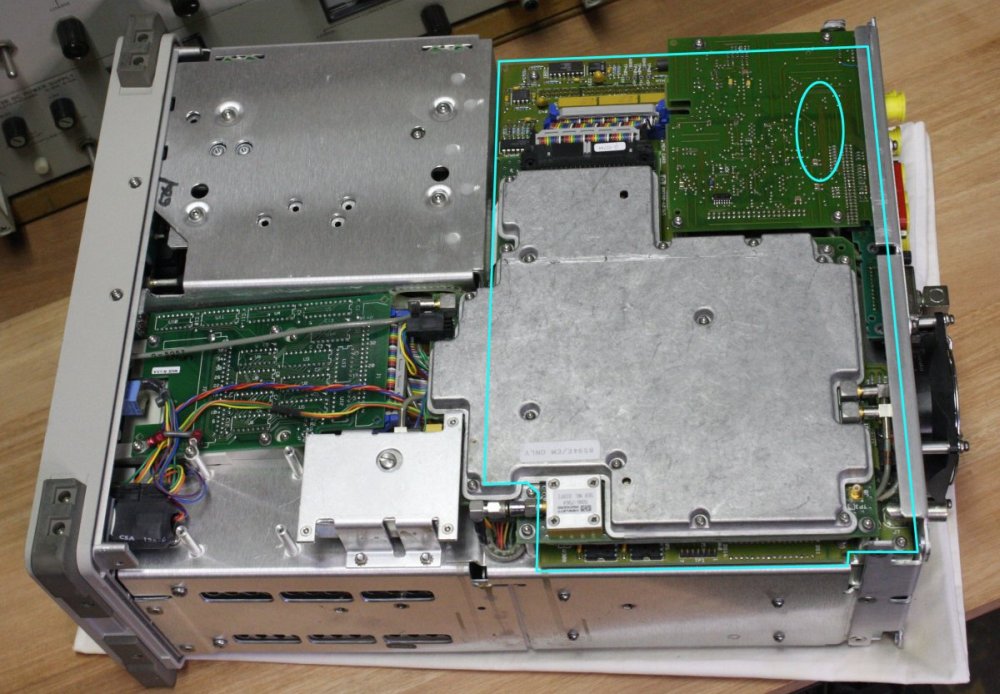
The battery is on the outlined CPU card, about where the oval is above. Obviously some layers of stuff have to be disassembled. This is no problem, especially since there's a clear instruction sequence in the service manual.
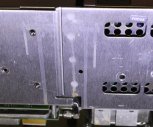 |
 |
It cleans off easily leaving no stain, so it wasn't significantly corrosive. I suspect coffee.
Previously while cleaning the machine outside case I'd noticed a small amount of brown residue, around that row of ventilation holes. It cleaned off very easily. Now I'm thinking it was a spray of drink, and some had got in through the vents, then dribbled down the frame.
Till I get the boards out, I can't tell whether there is any surface contamination, possibly conductive, that may be related to the faults.
That's a stunning splurt of Stupid. Someone spilled drink into an instrument worth many thousands of dollars new. I can't yet find a HP price list from the late 1990s. But here are the HP 1998 Catalog pages for the 8590E-Series Spectrum Analyzers.
Before I start in on this piece of gear, that despite being 20+ years old is still rather expensive, there is something else...
In all my electronics career I've never bothered with 'anti-static stations', wrist straps, conductive mats and so on. I prefer the alternative — simple movement habits that control and dissipate static charges via paths other than through electronics. Always touching metal equipment frames first, or ground points on cards. Keeping some skin touching metal frames at all times when working on gear. If picking up or putting down some static sensitive part, first palm-flat on the surface, to equalize potential. Desk surfaces are always slightly static conductive, just from normal dirt, sweat, etc contamination.
So far as I know, this always worked - I never static blew a component. (Fumbling a charged CRT EHT lead against a deflection PCB in a Tek 7104 scope - that's a different kind of Stupid screwup.)
But with this spectrum analyzer, that means (and cost) so much to me, I want to be super cautious. Why not set up an anti-static work area for this.
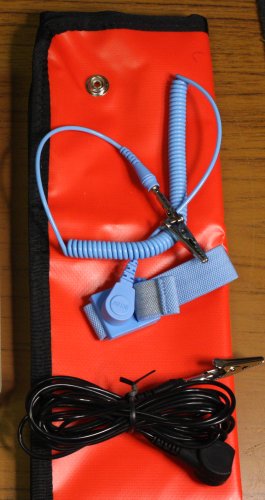 On Feb 14th I bought a "UCSTAT" anti-static mat and wrist strap from Jaycar. The only type they had. If I'd bought a real one from the net, I'd have had to wait for it to arrive.
On Feb 14th I bought a "UCSTAT" anti-static mat and wrist strap from Jaycar. The only type they had. If I'd bought a real one from the net, I'd have had to wait for it to arrive.
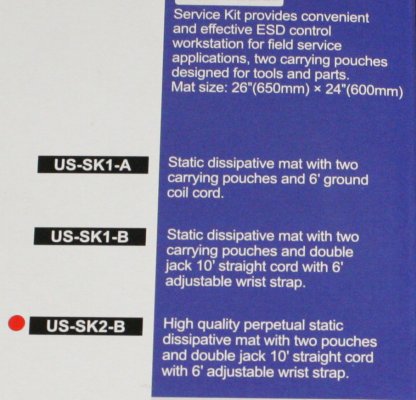
It cost $39.95. I wondered what 'perpetual' means in "High quality perpetual static dissipative mat."
As expected, the wrist strap lead end to end is 1 meg ohm. The black ground lead is direct wired from alligator clip to wrist strap sockets, and 1 meg to the mat pop-clip. So that's fine. But what about the mat? It looks like just a sheet of vinyl with a pop-clip in one corner. Hmmm... This is made in China, why not be suspicious? I am a 'perpetual' cynic.
First quick check, that I didn't expect to work: Press a metal pad on it about 1cm from the pop-clip. Put 25V DC between the pad and clip. See if a multimeter (Fluke 77) can see any differential voltage between either pads, and points on the sheet between.
A: Not a sausage. No detectable conductivity.
I guess it's expected to be very high impedance, to only move electrons around a little. Expecting a garden variety multimeter to see anything may be unreasonable.
OK, so how to give it a fair test?
I have this:
 |
 |
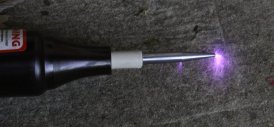 |
It's a hand held tesla coil thingy. Applies really really high voltage, high frequency excitation to whatever is near the tip. Typically used to find leaks in vacuum glassware, because electrons will find even the tiniest passage. You look for where the glow goes. Even with nothing nearby, there is a corona glow around the tip, visible in dim light. Anything nearby makes the corona concentrate in that direction.
Point being, to this thing even many 'non-conductive' objects will pull an arc from the tip. Dry concrete, wood, paper, etc. You can judge how conductive so-called insulators are, by how much the corona discharge is drawn to them.
The last photo is it resting on dry concrete.
Not sure if it would be lethal to touch the end. I never have. Probably survivable (depending on duration), since the frequencies are high enough that skin effect would probably confine most of the current to a thin surface layer. Anyway, it would be death to electronics, so I avoid using this thing in my lab. Only outside.
I bet it makes a mess of the radio spectrum too. Heh, once my spectrum analyzer is running, I'll be able to measure that. From a distance.
Let's try this on the 'anti-static mat.' First quick try:
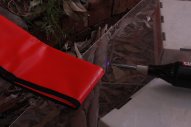 |
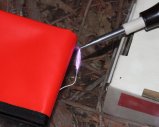 |
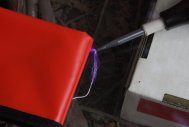 |
The test platform is a sheet of perspex, spaced up off the ground on cardboard boxes. The mat other end is sitting on a concrete step, that serves as 'ground'. (No really, for this it's good enough.)
It's late dusk, 2 second exposure, camera on tripod.
I was being eaten by mosquitos, hence rushing.
1. HV tester tip is about 1cm from the closer mat corner. Hmm... From my experience with the 'leak tester', that mat is no more conductive than any ordinary plastic.
2. For a comparison, a bit of wire with its other end point-touching the concrete. Competing in arc length with the 'anti-static mat.' Note that almost anything will draw the arc a little, even small objects in free space, since the arc is HF AC, and most things have at least a little charge mobility. Even plain vinyl plastic.
3. Same, but even larger gap to the wire. Result: higher voltages at the tip, and a little increase in corona to the mat.
All right, I need something that could be considered a fair competition. Let's see how the 'anti-static mat' compares to... bubble wrap.
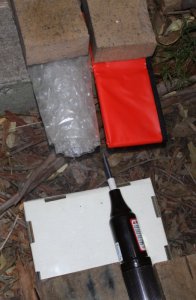 |
 |
Left: The setup.
Right: Running.
Good heavens. There's no discernible difference.
This made in China 'anti-static mat' is no more conductive than plain bubble wrap. It probably is just a bit of cheap vinyl sheet.
That's really funny.
Apparently "perpetual static dissipative mat" means the static discharge time is 'perpetual', ie forever. So they are not actually false advertising.
Industrial scale Stupid. How many thousands of these are sold?
Meanwhile, I have no anti-static mat.
Great.
I returned the red vinyl sheet kit to Jaycar the next day for a refund. Then bought an actual conductive mat from Element14. "082-0002F2 - Anti Static Mat, Conductive, Rubber, Black, 500mm x 700mm x 2mm"
This time with a data sheet stating conductivity. A little cheaper, no wrist strap, but with postage and GST it came to $53.30.
 |
 |
 |
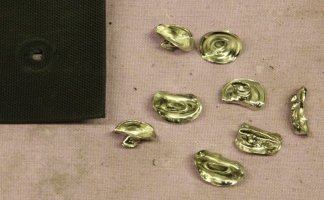 |
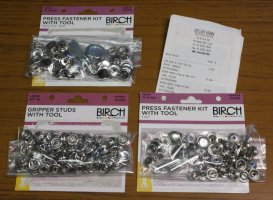 |
1. Amusingly, this anti-static mat came in an anti-static plastic bag. Perhaps to protect it from static?
2. In contrast to the Jaycar sheet of vinyl, this one is definitely conductive. Around 1 K ohm average between any two pop studs.
So that's a start. But lacking a wrist strap it's not an 'anti-static workstation.' Also there's a few irritating defects:
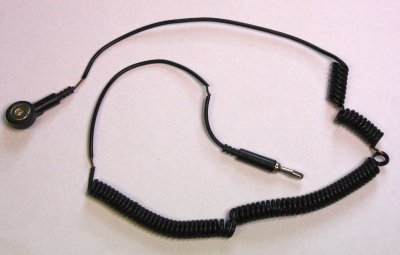 Not another instance of the 'everything is crap' syndrome, of which that red vinyl joke was an example, and so is the black rubber one really.
Not another instance of the 'everything is crap' syndrome, of which that red vinyl joke was an example, and so is the black rubber one really.
Here's another: I have a couple of the coily stretch leads typically used with wrist straps. They are identical, except one's plastic wire sheath is disintegrating with 'plastic rot', and the other's banana plug has broken off due to a manufacturing defect.
If I improvise something once, I can do it again. So time to improvise.
4. First, remove all four badly done pop studs from the mat. I'm only going to put two back, so the front edge will be flat. And they'll be from the other side, so the mat doesn't curl up.
5. Buy an assortment of pop-studs and the mating parts. One of these is the same as was on the black mat; another is the small type that's used on the commercial wrist strap.
 Those came from an Australian sewing accessories store called Spotlight. There used to be an outlet only a few minutes drive away in Bankstown, but since few actually make (sew) things anymore, that closed a couple of years ago. Now the nearest is 14 Km away, in Miranda.
Those came from an Australian sewing accessories store called Spotlight. There used to be an outlet only a few minutes drive away in Bankstown, but since few actually make (sew) things anymore, that closed a couple of years ago. Now the nearest is 14 Km away, in Miranda.
Annnnnd... There's no escaping the Stupid.
Those packs of studs come with the forming punch tools included. The type I'll likely use most is the largest 'heavy duty' type. In that pack, the three punch tools are the wrong type. They are a set for some other sort of rivetted clothing fastener, I don't know what kind.
Never mind, I will have whatever is needed to secure these.
 |
Click to enlarge.
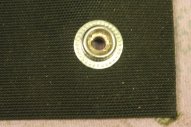 |
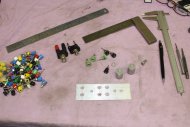 |
 |
 |
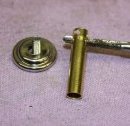 |
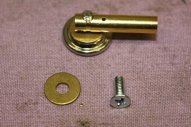 |
1. A new stud on the rubber mat. With a properly shaped forming punch the inner rivet ends would be turned back under, looking neater. Never mind.
2, 3. A plug panel for the anti-static grounding leads. The mounting holes are spaced to fit a 19" rack strut holes, or a mounting flange on equipment.
4. 'Best available ground' is via the mains outlet ground pin.
5, 6. A connector to the pop stud on the rubber mat. With female banana plug receptacle, to allow use of assorted banana jack leads.
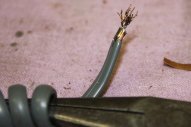 |
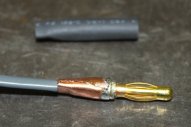 |
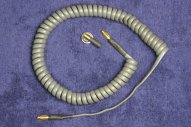 |
 |
What's a good source of light coily stretch leads, for a wrist strap connection? Old telephone handset cords. Just wire all four conductors together.
1. Each lead is a thin copper foil spiral-wrapped around a cotton thread core, for flexibility. For a good solder connection I wrapped a small piece of copper foil around them all, and solder filled.
2. For strength at the connectors, a metal sheath and a piece of heatshrink tubing.
3. First try. It works well, but has one drawback — there's no resistor in series. For safety with the wrist strap, there has to be a 1 Meg-ohm resistor in series, at the strap pop stud. This is in case either you or the other end of the wrist strap lead somehow contacts live mains or other dangerous voltage.
4. The wrist-strap pop stud end of that decaying plastic commercially made lead, is like this. A 1/4W 1M series resistor revealed after cutting away the plastic.
 |
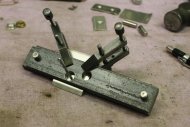 |
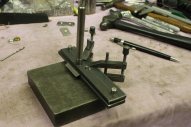 |
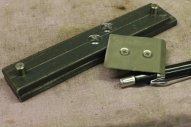 |
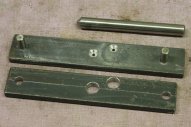 |
1. So naturally, begin with some grinding. Heh, actually this was after a slight false start, making a plain flat wrist contact of sheet stainless steel. It needs formed countersunk recesses for screws for the studs. I had a punch tool for making these, but then decided the plate needed to be formed to a shape to fit the cloth strap. Which meant making a new punch. Here grinding a better 45° tip on a bit of hardenned steel.
2, 3. The new punch jig in use.
4. Result. Screws are M3 stainless. This is the face that presses against skin, so it has to be without any sharp edges.
5. Disassembled punch. I'd made one hole in the middle, before realizing that I needed the hole to be close to an edge.
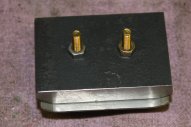 |
 |
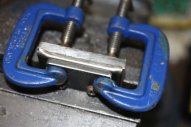 |
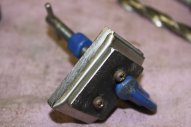 |
 |
1, 2. The shape of sheet stainless steel contact pad I wanted, would require a forming jig while hammering the sheet into shape.
3, 4. The sheet stainless beaten to shape around the jig.
5. End result.
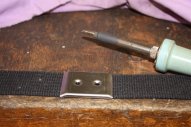 |
 |
 |
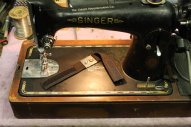 |
 |
1. Marking holes in the strap with a soldering iron. The material is synthetic and melts, preventing frayed ends.
2, 3. the skin contact pad and connector studs.
4. Sewing on some velcro strips. Yes, it's a very old sewing machine. This is the oldest of about eight in my collection.
5. Finished.
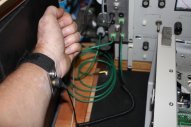 |
Until I figure out a robust way to include a 1M series resistor in the 'telephone lead' method, I'll use this commercial coily lead.
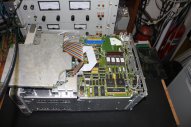 |
 |
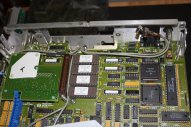 |
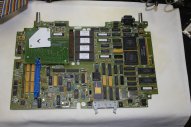 |
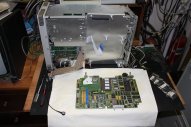 |
1, 2 The diecast shielded block is the "A25 Counter-Lock" module. The three tiny brown spots on pic 2 are the only sign of that drink spill I could find so far on any of the boards. That's not good, since it means the fault isn't going to be as simple as cleaning off some gunk.
3. I was taking lots of photos of lead routings, so I can reassemble just the way it was. No need to include them all here. Hmmm... the backup battery area is giving me a bad feeling.
4,5. Since the anti-static mat is so highly conductive, I can't risk placing a PCB that carries battery power, directly on the mat. So, here using some old linen cloth (a pillow case) as a sufficiently insulating buffer. It's not going to generate any significant static charges, I only pick the PCB up by metal ground points (like the BNC connectors), and soon after this I started keeping it clipped to one of the '1M ohm to gound points' on my plug board.
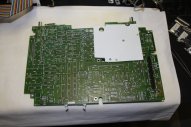 |
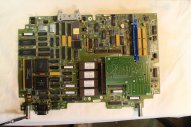 |
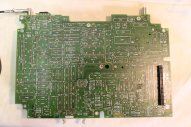 |
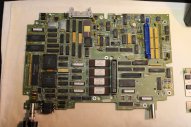 |
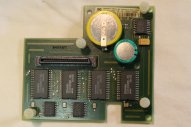 |
1. Initially such caution re the battery may have been superfluous, since the board has insulating shields over the battery area. But these shields are coming off...
2. Because first priority is to measure the backup battery voltage, and this whole area doesn't match the docs I have. What's going on? The docs place the battery, supercap and CMOS RAM chips on the main CPU board. But here they are all moved to a small rider board.
The reason is obvious enough — it allows battery replacement soldering on just a small PCB, without risking damage or contamination to the very expensive CPU board. But it also means the schematics I have will be quite wrong for this version.
Anyway, now I have access to the battery terminals. It measures 3.057V. Which is well above the range at which CMOS RAM would risk losing data. So that's good. There's no sign the machine has ever previously been taken apart, and if anyone did replace the battery they'd have noted that on the rear panel sticker. So this one almost certainly is the original installed in June 1996.
Which fits with the IC date codes I can see; they are mostly early 1996, with a few late 1995. The instrument was probably assembled mid 1996.
The battery is a Panasonic CR2477. 24mm Dia, 7.5mm thick. Marked "3V" so is still at rated voltage. However it is 23 years old, so I'll replace it before I reassemble the machine. Not urgent.
3, 4, 5. Shots of the boards.

Most of the changes are at top left, around the battery backed memory. But that's not the only section differing.
The CLIP set is dated 1991, and my machine is from 1996. Different versions.
My instrument is SN 3624A03030, and the only label I can see on the CPU PCB is "PROCESSOR 08590-60365 B-3523".
Well that's awkward. It means I can't rely on the schematic to be correct, when hunting the 'slow response' problem.
I wonder what the chances are of finding a CLIP set (schematics, board layouts and component lists) for this version?
Part nummber Checksum
U7 08590-80245 5F01
U6 08590-80244 E501
U23 08590-80246 CC01
U24 08590-80247 2D01
Zip of contents: HP_8594E_EPROMS.zip
Just 296KB. There's a lot of repetition and blank blocks in the EPROMs so they compress well.
There are also at least 6 DIP PLDs (programmable logic devices), soldered in. The bane of long term maintainability, because if they fail you cannot get them, and they are likely programmed with 'protect' bits enabled which means the underlying code cannot be read out in order to program a new one. And because they are unobtainium, even desoldering them to see if they are readable, has a high risk exposure.
First thing: can I get the machine running somewhat normally, with the CPU card accessible? Which connectors are essential, which can be left off? The big A25 'counter-lock' module has to be either left off, or cables improvised to have it slung out of the way.
To do:
8590DE-CLIP.pdf 8590E-CAL.pdf 8590E-L-CLIP.pdf 8590E-SG.pdf 8590E-UG.pdf /AgilentBack when these arrived I didn't know what year my 8594E was. I'd skimmed the top CLIP file, saw it seemed to match, and copied it to my working folder. Didn't notice (or forgot) there was a second CLIP file. So, guess what that one is? Yeah, the right one, dated 1997. It took an email to Artek asking if they knew of a more recent one, and Dave of Artek pointing out that I should already have it. Sorry Dave.
I'd already carefully visually checked around the PCB edge where there might have been some of that liquid spill contamination. Found none. Now before installing the card again I gave it an all-over close visual check.
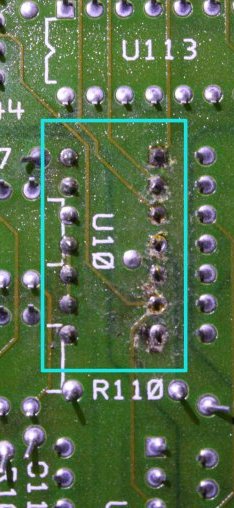
What is U10? Well look at this. One of its gates is the 14 MHz CPU clock driver. With pins 4, 5 & 6 among those resoldered.

Interesting. The machine shows no sign of ever having been opened since manufacture — no lost screws, no marks, all cables neatly arranged as they would have first been. Those U10 re-soldered pins might have been a production fault fix. Something wrong with the clock to the CPU, looking like an intermittent solder joint? Resolder pins, fault went away, and the machine was shipped?
Now I'm dying to put a scope on that CLK2 signal. But... until I'm absolutely certain that powering it up with the big shielded 'counter-lock' module disconnected won't do any harm, I can't. I know it probably would be OK, but that's not the same as 100% certainty. Frustrating.
I cleaned the flux off with IPA, and assembled the CPU card back into the machine.
 |
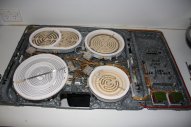 |
 |
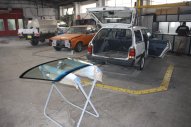 |
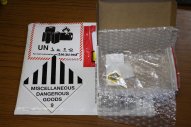 |
Meanwhile the usual distractions.
1. The kittens are growing, and when not dozing like now, are being either hilarious or kawai or mischievous, or all at once.
2. An element of my old mum's radiant heat stovetop died. Whether a replacement part will be available or not, remains to be seen. (Answer: no longer available. Thanks a lot, AEG.)
3. Repairs to my car are almost done. Here cleaning a spare windscreen I had stored, from a scrapped car. Needed to put into my current car since the repairers broke the one in the car during rust repairs.
If a new one without that stupid blue tinted band across the top was available, I'd have bought it. But no, none are available without the tint. I hate that tinted band very intensely. It ruins the aesthetic quality of sky views while driving. Having this kind of insensitive, moronic crap imposed on me against my will, pisses me off a lot.
4. Ready to go in.
5. The replacement backup battery for the Spectrum Analyzer arrived. $6 for the battery, $20 for post (just across Sydney) plus GST makes $29. Expensive little thing. Here's the packing; ridiculous overkill because it's a very scary lithium battery.
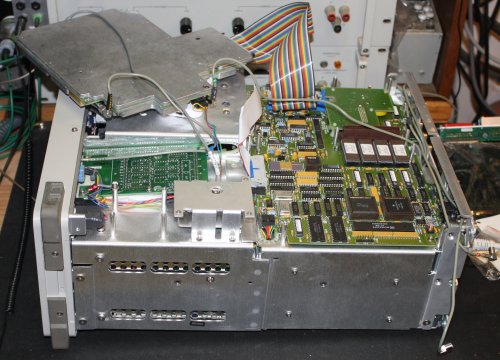 20190322 Back to it.
20190322 Back to it.
With a couple of extra SMB coax cables, it's possible to wire up the metal-cased "A25 counterlock" to run, while out of the way.
There was a heart-stopping moment when powering this up. The fan runs, there's the usual series of clicking noises (an attenuator?) but no screen activity.
Thinks: "Oh no, what have I done?" After a few minutes of panic, thinking 'how ironic, I make an anti-static station, and then I static-zapped something', I discovered that while moving the machine around I'd accidentally turned the screen brightness knob to zero. With brightness turned back up the machine is running the same as before. Phew.
Finally checking that suspect CPU clock signal, was not so pleasing. Because it's perfectly normal. So are the power supply rails. Therefore the fault (still present) is something else. Oh well, that would have been too easy.
I'd also wondered how the software would react to missing modules. In the photo above the card reader module is not connected, and the machine doesn't complain. Same result with just the external I/O card missing.
Now I know roughly what the signals to and from the A25 counterlock module are, and am certain nothing else would be damaged if the module is omitted, I tried the machine without it. And got a big surprise.
Suddenly the screen and controls are behaving correctly! The startup screen info sequence is correct (now it displays the software revision number initially, which it didn't before), it's displaying scan traces at a sensible speed, and the keys are working, with immediate screen response. That 'FREQ UNCAL' warning is gone.
Hmmm. Actually this is not good. It suggests the fault is in the A25 counterlock module. Something to do with accessing it, is tying up the CPU.
Bah. Just before I tried that, I'd decided the next thing I should do is replace the backup battery. Despite the small but real risk of losing the calibration data during that process.
But now the machine responds to controls. And so logically the next thing I do, should be to go through the steps of manually saving the calibration data. It's a tedious chore, detailed in the manuals. Also, depending on what's wrong with the counterclock module, maybe I'd have to do a recalibration anyway, after fixing the fault?
Oh wait. There's something else to do now the keys are working. The instrument has 'user memory' that can hold programs and data. According to the manuals and comments in the eevblog thread, these can potentially cause problems. There are key commands to list memory contents, and erase it.
Having a look via [RECALL]{Internal}{Catalog All} shows there are about a dozen 'files' present. (Oops, I should have taken a screen shot.)
The recommendation is, if in doubt delete them. Via [CONFIG]{more}{Dispose User Mem}{Erase DLP Mem}
Hmm... In that same set of softkeys there is also {Erase Mem All}, that wipes any saved state, trace and pretty much everything else too. But the manual says this does not erase system globals and calibration data. So I did that.
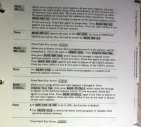 |
 |
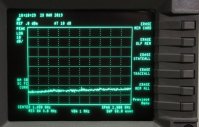 |
1. There's a 'Key Descriptions' chapter describing the effects of each 'key' (front panel buttons and softkeys) in alphabetical order. Each entry mentions the front panel button to access it. This list is 95 pages long! With one to eight commands per page, typically six. Say 500+ unique commands. And that ebay seller seemed to think the User Guide was optional.
2. There's also a 14 page 'Key Menus' chapter, with tree diagrams of the nesting of softkeys reached via front panel buttons. Some of the trees are quite deep, with several softkey presses required to reach the desired command. So it's often necessary to look up these diagrams to find a command.
The little Quick Reference Guide booklet is very useful too.
So, did clearing the user memory have any effect? Reconnected the counterlock module to find out, and.... nope. Dead controls. Or rather, as before the response is veeery slow, intermittent, and some commands don't seem to work at all.
Still, I started trying to run the self-diagnostics. The 'confidence test' fails; it can't see the Cal signal. With the 'Service diagnostics' the first few work then one requres the SPAN parameter be set to 10MHz via the front panel. Which requires at least 4 button presses in sequence and it's impossible. Foo.
Quite a lot more reading, mostly in the Service Manual. Which is 670 pages, I only have it as PDF, and it seems somewhat random. Urrgh. (I wish I had a paper copy, but so far haven't found any on ebay.)
Then pretty much by chance I came across this. On page 561, in a list of service-related softkeys.
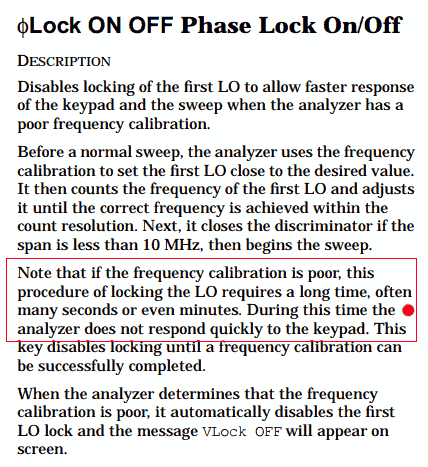
What an understatement. Thanks a lot HP.

This softkey is deeply buried in the menus:
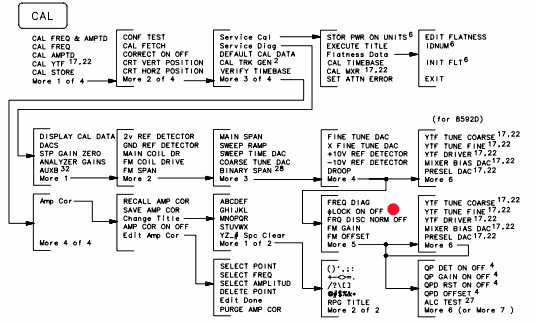
There's no mention of this in the basic fault-finding checklist. Nothing like "Is it responding very slowly to keys? Then see..."
So apparently if the CPU tries to use the A17 counter-lock module to adjust the first local oscillator, on this machine it takes ages. During which the CPU doesn't handle keys normally. And this command can disable attempting to run that adjustment before every sweep.
I turned it off (with a long delay after each key press while navigating that tree) When it finally accepts the command, the keyboard springs to life and sweeps refresh quickly. OK! That explains why the 'freeze' goes away if the counterlock module is absent; the software recognizes the module is absent, and doesn't try to use it to adjust the LO.
Next question: Is the 'first local oscillator' actually way off frequency, or is there something wrong with the counter-lock module, which just makes the CPU think the LO is off frequency?
More to the point, how do I find out? Lots more reading I think.
Also I'll have to print out the Service Guide theory of operation section and block diagrams. It's a complicated machine, and I find the awkwardness of trying to scroll around large diagrams on a screen, a great impediment to comprehension.
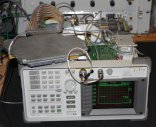 |
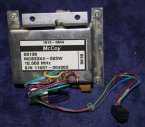 |
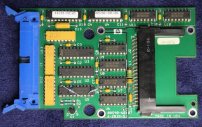 |
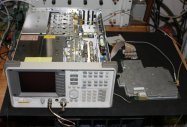 |
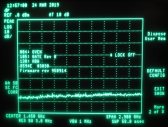 |
1. Upside down isn't very convenient.
2. To improve arrangements, the 10MHz reference osc has to come out. Because its power lead isn't long enough to reach a relocated A25 (where it comes from.)
Hmm, I didn't notice till seeing the photo, that there is some of that spilled drink stain on the underside of the frame at the right there. Easily cleaned. There's none on the feedthroughs.
3. One of the mounting nuts for the 10MHz Osc can't be accessed unless the card reader is removed. So here's the card reader too. With original HP mods, which is amusing.
4. There, right way up, that's much better.
5. List of this machine's options, via [CONFIG] {more 2 of 3} {Show options} Firmware rev: 950914.
I'd also noticed the screen is starting to show some intermittent quick variation in overall image size. Typically this is due to variation in the CRT EHT. At some point soon I'll have to take the CRT unit out, clean it and hunt down the cause. Could be just dust on CRT around the EHT connector.
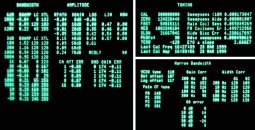 |
Whether that is actually all of it, and whether all the values are sane, remains to be seen.
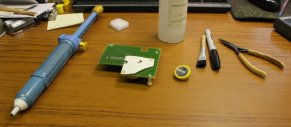 |
 |
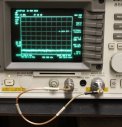 |
1. Changed the battery. Pic is when done, since I didn't want to muck around with the camera while the RAM was running off the super cap with no battery. Incidentally, the real time clock is on the CPU card, but powered from the battery on the RAM rider board. So removing the RAM rider board makes the instrument lose its date/time. Just reset them after. This is right at the top of the [CONFIG] menus.
After reinstalling the RAM card in the machine, the cal data looks the same. So that worked.
2. Unlike... Since now I can use the front panel controls (tediously resetting that 'lock off' control after each power up or Preset), I thought I'd try a few basic tests with the instrument. This first one is with a 50 MHz ~1.2Vpp signal into the SA input. Set SA center freq = 50 MHz, Span = 20 MHz, Atten = Auto.
Result: It sees nothing. Just that constantly present noisy floor.
Oh oh. Turning 'lock off' should just make the instrument not so accurate. It shouldn't make it completely deaf. Looks like there's something more serious wrong than just some frequency drift.
3. A similar test, but with the SA's own Cal Out signal. The DFM I'm using for these (Fluke 1920A) sees the 300 MHz signal (though of course the 100 MHz scope can't.) Set the SA center freq = 300 MHz, Span = 100 MHz.
Again the SA sees nothing at all.
Another: With the external 50 MHz generator looped --> DFM --> Scope --> SA.
Connect/disconnect the SA, gives the expected ~50% amplitude change at the scope, due to the SA's 50Ω input impedance.
Now with that chain connected, using the SA [Amplitude] {more} {Input Z 50Ω/75Ω} toggle, should result in a small amplitude change at the scope. If the SA actually changed input impedance.
Result: no change. The SA input does not change impedance. I had wondered how it could change, given that the input goes through a significant length of coax inside the machine, and that coax will be 50 or 75 impedance.
Looking it up in the manual: Ah, it can't. This command is just a computational adjustment, for use when using external impedance matches to different systems.
Looked at the output of the 10 MHz ref osc with scope and DFM. It's about 5Vpp, 10.000MHz. So that's working at least.
However, I did that with the SA running, and disconnecting/connecting the 10 MHz ref from the counterlock module's J2 made absolutely no difference to the SA screen state. While it's supposedly running frequency sweeps.
The 300 MHz signal to counterlock J1, shows up on the DFM as 300 MHz.
Well, that's disappointing. There's no point trying to run any self-cal routines, if it can't see anything on the input. Since I don't yet understand the overall theory of operation, there's no use trying to delve further into the circuits at this stage. There are a bunch of service diagnostic routines to run, but reading through those I do not yet understand the functions/modules they test. I really need to just study the theory of operation now. For which I need decent sized prints of the diagrams. This implies a bit of a sidetrack, since I bet my A3 photocopier/printer will be a struggle to get working. Maybe better to just get them done commercially. Assuming still no luck finding an original Service Guide.
Then there's the real possibility that the fault may be in some unobtainium part. A custom HP sampler block or something. Fingers crossed. But considering how unlucky this project has been so far...
The big question, is whether to put the SA back together and leave it for a while now. There are other things I have to do urgently, and this whole 'buy a spectrum analyzer' thing was not supposed to turn into a major time sink (as it has.)
Sigh.
Anyway, teardown time. Here's the A25 Counter-Lock board with the covers removed.
 |
 |
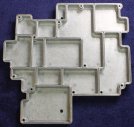 |
To recap:
Searching for this immediately turned up a very distressing circumstance. To explain this will need some background first.
The early pioneering test equipment manufacturers like Hewlett Packard, Tektronix, General Radio, etc were founded and directed by real engineers. An engineer's objectives can be distilled to 'create things for the betterment of humankind.' And so that's what such companies did. To an engineer it's fundamentally obvious that a buyer of any piece of test equipment has a right to full technical documentation of that instrument. Sufficient to operate, maintain and repair the equipment themselves.
And so there was a golden age of test equipment, with the gear being both technically excellent and fully documented. It generally came with amazingly complete 'operation and service' manuals, complete with full schematics, theory of operation, and detailed repair and calibration procedures. If these weren't supplied by default with the equipment they were available separately for a reasonable price. Unless you've actually held one of these manuals in your hands, opened it up and flipped through the dense technical information, marvelled at the beautifully drawn huge foldouts full of schematics and so on, you can't imagine what they are like. You don't know what a 'user manual' should be like, and how pathetic later (contemporary) imitations are.
This era lasted till roughly the early 1990s. By that time the original founders of all the major equipment makers had grown old and retired. The companies were all corporatized, and had been taken over by bean counters, MBAs, CEOs reeking of lawyer-think. To these types it was inexplicable why a company would publish internal technical information about their products. So many reasons not to... giving away trade secrets, more profit to be made by forcing customers to pay for repairs, making old 'unsupported' equipment die and therefore boost sales of new equipment, not to mention the cost of producing those complex old manuals. Plus a more general corporate/globalist mindset that 'all knowledge should be owned by corporations and therefore hidden from ordinary people.'
For my part, I have some project ambitions that require a considerable amount of high tech electronics gear. Brand new would be nice, but is both utterly beyond my financial reach, and typically cannot be user-maintained. Whereas older gear is available and affordable second hand (via US ebay), and while it tends to need some maintenance, that is entirely feasible. Since the older gear had such excellent service information available, in original paper form. There's a lot of scanned copies around too, often for free, but with the drawbacks:
A critical factor that made acquisition and use of older electronics test equipment feasible, was the existence of several large libraries of original service manuals, available for purchase as needed. With them and their collections of sometimes tens of thousands of manuals, there was generally a pretty good chance of finding whatever manual one needed.
I'd known one of the larger of these manual archives had shut down recently. A sad development. But now when I checked through my list... oh no! They are all gone!
The main ones:
Your Manual Source (Carla)
http://www.consolidatedsurplus.com aka http://www.usimperio.com aka http://www.yourmanualsource.com
Consolidated Surplus, P.O. Box 106, Ellicott City, MD 21041. 410-685-1991
Web site is now a cybersquatter 'math tutor' but no links.
HP Computer Manuals http://www.manualserver.com/hpmanuals5.htm Gone
Sarrio http://www.sarrio.com/sarrio/hpmanuals.html Gone. Cybersquatted
Jim Tucker's site https://www.etestmanuals.com/ Now only sells PDF.
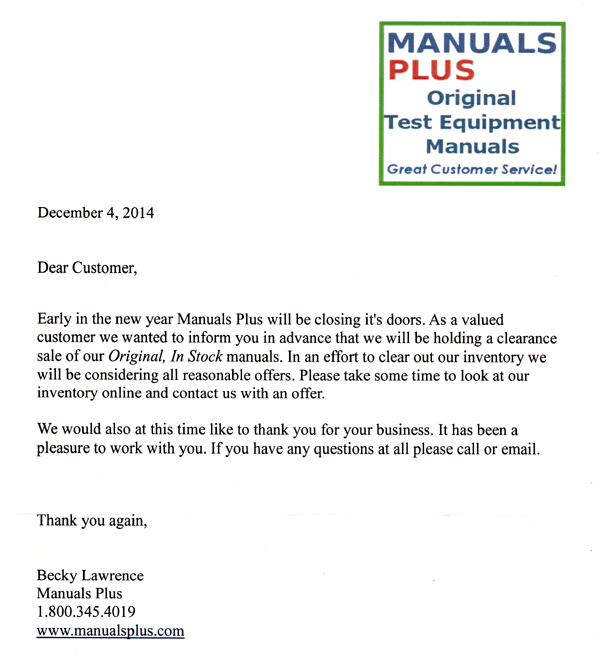 The story of the shutdown of Manuals Plus in August 2015 is particularly tragic, because there are pictures of what was lost.
The story of the shutdown of Manuals Plus in August 2015 is particularly tragic, because there are pictures of what was lost.
The first I heard of it was in an email from ManualsPlus on 09 Jan 2015, regarding a manuals order.
"By the way... We are closing our doors in the next couple of months..."
Oh no!
← It turned out they'd sent this flyer earlier, but it went to my US reshipper address, and I'd let it sit while building up some other things there to combine shipping.
I learned they were giving discounts of around 50%, and selling their 'masters' (ones they only had one copy of, and would normally only sell photocopies.)
When I finally read the flyer I didn't realise the absurdity of the phrase "effort to clear out our inventory." I was struggling to prioritize a list of manuals I wanted. There was definitely no way I could afford to buy many even with the discount.
With my small order of manuals completed I didn't hear anything more of Manuals Plus until 16th Aug 2015, when this popped up on eevblog forum: Rescue mission - 25,000 manuals, Baltimore.
 |
 |
 |
 |
 |
 |
 |
 |
And now it's all gone.

There was a similar cultural heritage disaster here in Australia some years ago. There's a company called High Country Service Data. They still exist and the 'About HCSD' section of their web site tells quite a story. (Though with no direct URL of its own, so here is a local text copy for historical reference.)
For many years HCSD functioned as a 'renting library' of technical service manuals. They had a huge stock of original manuals, and for a fee would post you either an original on loan (to be returned by post) or a photocopy you'd bought. It was an excellent service, that I'd used myself a few times in the 1990s.
Where they mention hard economic times in Australia from the 2000s onwards, they are not kidding. Causes are complex, but can be distilled to 'our government are a pack of stupid, ignorant, self-serving, corrupt and traitorous bastards.'
Anyway, in order to survive HCSD felt they needed to switch to digital. Apparently between 2000 and 2005 they scanned their library of manuals. Fair enough. The next decision was the problematical one.
Sometime around 2014, I don't recall exactly when, I needed a manual for an old BWD Model 530A oscilloscope I wanted to restore. BWD were an iconic Australian manufacturer of electronics test and measurement equipment, long gone. I phoned HCSD to ask if they had the manual. The conversation was fairly brief. HCSD said they now only provided digital copies. I asked what happened to the originals. They said they had disposed of (destroyed) them all, to cut storage costs. I rapidly backed out of the call, said goodbye politely. I knew if I kept talking I'd end up shouting insults, and there was nothing to be gained from that. What's gone is gone.
One can see their reasoning. If they gave their manuals archive away, offered it for sale, or donated it to the Australian National Library, it would still exist — and potentially act as 'competition' to their own digital manuals sales service. But seeing their reasoning doesn't mean I think it was the right thing to do, or sane, or in any way morally acceptable. I think the people responsible for that destruction should all be in gaol for massive and despicable cultural vandalism. But of course there is no such law, though there should be.
Perhaps I should buy a few of their 'digital copies' to see what the quality is like. But I don't really want to, because they did the scans with the technology available from 2000 to 2005, which means the quality and file structuring will be pretty poor. It would be even more depressing.
The High Country Service Data story is illustrative of an underlying cause here. A kind of widespread delusion, that scanning an original paper document to electronic form results in an adequate substitute for the physical original. Thus the original can now be disposed of as garbage; a waste of space. And that this 'logic' can apply to entire libraries of precious printed works.
This is the modern equivalent to book-burning savages, and infamous civilizational tragedies like the burning of the Library of Alexandria. Repeatedly.
There are so many cases of knowledge and history destruction, involving libraries and collections large and small. Here are some examples I've personally encountered.
This one was an example of insurance policy rules enforcing stupidly pointless destruction of a precious and irreplaceable knowledge resource. It also sets the theme, of most people seeming to regard books as something to either ignore, or get rid of as quickly as possible. Like they are some kind of poisonous substance. Certainly nothing to be valued and protected.
My grandfather Myles Dunphy was an exceptional man. [Refs: 1, 2, 3, 4] By profession a lecturer in architecture, he was among the early Australian recreational bushwalkers, and a founding member of the Mountain Trails Club. On foot he explored much of the wild and rugged area now comprising the Blue Mountains National Park, drew the first detailed maps of that area (and others), named many of the landscape features (and made the names stick, since he was on the Geographical Names Board.) He was a driving force in the original declaration of the area as a great national park and wilderness area.
He'd personally invented the lightweight oiled Japara bushwalker's tent, finding a suitable material and hand sewing the first versions himself. Incidentally, those who know the Australian brand of Paddy Pallin (walking/outdoors gear shops) may be amused to hear the story of how that brand came to exist. Paddy Pallin was one of my grandfather's mates in the Mountain Trails Club. Others in the club saw Myles' new tents, and wanted him to make copies for them. Myles was too busy and didn't need the money. Paddy took on that job, with my grandfather's approval, and that business expanded to become the Paddy Pallin company. Trust a Dunphy to pass up a great commercial opportunity, sigh.
Grandfather passed in 1985, aged 93. My grandmother Margaret passed in 1994, after nearly a decade living by herself in their home, that still held all of Myles' effects. They were both avid readers, so there were a lot of books. Many of Myles' books in particular were of historical significance or rare.
As a child I'd enjoyed reading his large collection of the early Science Fiction periodical Amazing Stories. In later years these sat stacked in the hall bookshelves, where I'd now and then pick one up and remind myself of childhood memories. I treasured them very much (and was then the only family member to enjoy that genre of fiction.) They had remarkable cover artworks in colour, the rest of the magazine was B&W. Due to age and low quality paper, quite a lot of the covers had come loose. These were for some reason all placed together on the top of the pile.
One day passing in the hallway I noticed the bundle of loose covers wasn't there. I asked my grandmother where they went. I still remember my shock to hear her say "Oh, those had come off, so I threw them out."
There wasn't any point getting angry with her. Age dims the mind, and nothing can be done about it. But I cried inside. I did end up inheriting those magazines, but the covers of perhaps one third of them being missing is very sad. Lesson: Don't leave precious irreplaceable cultural works in the care of very old people. They can't be trusted to understand the significance or value of things, or act responsibly. Even if they once did know, and were.
Most of grandfather's conservation-related effects went to the Mitchell Library in Sydney.
But the house's small Library worth of books; those were mostly given away, dispersed, many even thrown out. I found that rather upsetting at the time. Apart from the somewhat coverless Amazing Stories collection I was given very few. Less than a dozen. I treasure them, but still... a personal library, gone.
By far the most galling of all, was the glass plate slides. %%% (Too painful. Perhaps later.)
One day while driving in Hurstville (not far from where I grew up) I noticed a large rubbish skip, of the kind normally used for building waste. Except the visible contents didn't look like the typical rubble. I stopped and had a closer look. It was full of what appeared to be someone's memorabilia. Including books (mostly about aeroplanes), photos (aeroplanes), some parts obviously out of jet engines, and much else. As I was looking, a lady came out of the house, and we started chatting. Her husband had been a pilot, ran a small air charter business, and been a member of an authority that investigated aviation accidents. He'd died some time ago, and now she was disposing of his effects before selling the house and moving away.
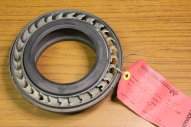 |
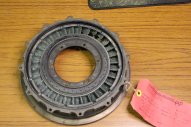 |
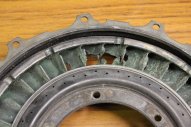 |
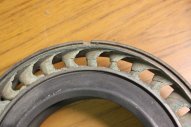 |
She didn't mind me salvaging items of interest, in fact was glad someone was interested. She told me stories related to a few of the items. For instance these jet engine turbine segments, very obviously seriously damaged. While flying the plane he'd noted that engine was failing to develop expected thrust. Several times had it checked by a mechanic, who claimed nothing was wrong. It got progressively worse. Eventually he refused to fly the plane till the engine was dismantled for a full check-out. This is what was found. It would have catastrophically failed pretty soon.
Apparently while clearing house it had never occurred to her to contact any of his friends and ask if they wanted mementos. So I got a stack of light plane and small jet operating and service manuals, aeronautical maps, and training manuals.
Another bin toss, this time in a household 'yellow rolley bin' for recycling. Driving near my place one afternoon before bin night, I noticed a rolley bin on the kerb, with its lid propped up, piled overfull, with... books. Slamming on the brakes I pulled over, got out and walked back. Yep, books. Apparently all the way down in the bin, which is chest high and quite large. I wheeled it over to my car, transferred the entire contents (nothing in there but perfectly good and mostly quite large books) then returned the bin, empty.
At home, going through them the story became clear. He was a doctor, and had spent years practicing in Papua New Guinea. He'd died, and now his surviving family or widow were throwing out his medical text books. There were some really great ones including Gray's Anatomy and several other famous texts. All it would have taken was placing one free advert on Gumtree, and someone would have gladly taken his library, saving the trouble of carting it out to the bin. I really don't understand. The part that makes me saddest, is that probably wasn't the only binfull put out.
What it says. Near my mother's place is a street of small shops. One of them is a second hand bookstore, that seems to receive a lot of books from a goodwill organization. Regularly one of the bins they put out is full of books. A few times I've rummaged in the accessible top of the pile. There's always a wild range of quality and interest, but I never failed to find a good stack of fine books. I suppose the shop doesn't want to put a 'free books' rack out front, as it would reduce their sales. All the same...
 |
 |
 |
 |
 |
 |
More of the same. And by 'more' I mean sometimes rooms full. Institutions like hospitals tend to have a lot of books, both for patient entertainment, and texts. When places like that shut down, it seems like no one can be bothered moving the books. I've walked in rooms knee deep in books; not possible to cross without walking on books. It's a strange feeling. Yes, there were books worth rescuing.
Another 6 story commercial building, where all the tenants had been given a two weeks notice to vacate so the old subdivided warehouse could be gutted to build trendy modern home units. One large space had a literal private library. It had been a law book company, and in addition to the law books they had maybe 10 long, tall rows of book shelving, full of all kinds of books with one common factor. They were all in Hebrew. And someone who'd found this space before me, had pushed over the end shelf, resulting in a domino collapse of all of them, spilling the books on the floor. This was very sad. It seemed to have been left that way for some time. Maybe the business owner had died or something a while before the notice to vacate. So no one knew.
But I was there only briefly, having a quick look round while helping some friends clear out one of the other businesses in the building. Nothing I could do for that terrible calamity of tumbled books.
 |
 |
 |
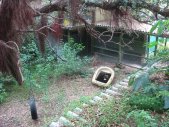 |
 |
Yet another instance, smaller but no less poignant. In Randwick, a line of old WWII era wooden buildings in bushland was long ago repurposed as a daycare center, then eventually abandoned. They'd sat empty for years, the bush reclaiming the buildings as the land went through negotiations to clear it and build high density housing. In a basement I found boxes full of someone's books. An interesting collection, all related to environmental and conservation issues. A note suggested the owner had been taken ill, gone on leave, then never came back. The books were moved to the basement before the place closed down. And stayed there, forgotten. It's all gone years ago, but I saved the books.
Our two children's early school years were at a private Montessori school. These places are run by parents, and someone gets elected as school manager. One year a new guy (who I didn't much like) was elected. One of his first acts was to throw out the entire school's library of parent-donated books, with the intent to buy all new ones. No good reason was stated. Some of the books were old, but most were in good condition and quite nice children's books. He was preparing to cart them to the tip when I found out. There were too many for me to take, plus children's books are not my thing. But I did take them to a Salvos shop instead of letting him just dump them.
Another example of high real estate values killing a wonderful cultural icon. I doubt there will ever be another bookshop like this in Sydney. So sad.
On the other hand, there was also a rather subtle form of anti-knowledge bias at work while that place was in business. Mr Gould was an old diehard Leftist. He had an anti-science leaning, and so the one 'hard sciences' isle in the place (upstairs, to the right) was heavily selected to contain books more on the evils and pitfalls of science and especially physics. Still, it wasn't absolute (or maybe not very organized) so there were still some great texts to be found, both old and new.
The Cornstalk second hand bookshop was further down the same road as Goulds. Much smaller but more organized than Goulds, and minus the anti-science bias. It closed years ago (again, rising rents making a 2nd hand bookstore uneconomical), and I really miss it. Because they had a 'technical books' room at the far back, that often contained some real gems. It's a mystery how they found them, maybe deceased estates? I don't know of any equivalent bookstore with very old texts on science and electronics these days. There are the online sources like abebooks.com, but they're no use unless you know a specific book's title. Not the same as browsing through shelves and finding unexpected treasures.
Except... Firstly the digital format used is PDF, with pages digitized in fax mode, ie two tone. The resolution used is adequate for readability, but the document personality and quality of images is lost.
But secondly and far worse, they mostly destroy the paper originals during/after scanning. Quoting the site:
In which case the net effect is: large numbers of old books and manuals being destroyed, where these works were specifically selected as being worth preserving. And the digitised files being of less than ideal quality and in the disgusting PDF format, plus the entire digital archive conceivably just disappearing at any time due to 'unforseen circumstances.' Whether by deliberate action or force majeure.
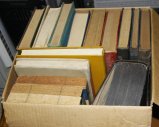 |
 |
 |
 |
 |
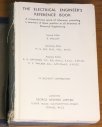 |
 |
 |
 |
 |
 |
 |
 |
 |
 |
 |
Here's a set of books I recently rescued from somewhere supposedly dedicated to preserving such things. They have boxes and boxes of donated technical books and manuals. Sitting in a space with book-chewing pests of all kinds, dust, wildly varying humidity, and even a roof leak. I didn't win any points by insisting on extracting this small boxful, and wouldn't have been allowed more. Knew this when selecting, so these are the ones I rated most worth rescue, in half a day of hunting (for something else, not found) and tidying there. Some are in a very sad state.
It's not the group's fault. They have an extensive collection that they are trying to maintain in a country (Australia) where there is little to zero official interest in preserving technical history. Also very little public interest. This country is well known to suffer from a kind of pervasive subconscious anti-intellectualism. It even has a name: tall poppy syndrome. Stand out above the crowd, and get cut down.
In the case of existing (and would-be) technical museums this manifests in severe funding difficulties. Even the best, most spectacular technical museum in Sydney, the Powerhouse Museum, aka Museum of Applied Arts and Sciences, which presently occupies the perfect building for its purpose (a giant old power station), perfectly located on the edge of the central city adjacent to a major rail and bus hub, is going to be destroyed. Greedy politicians and real estate developers have decided there's money to be made, by evicting the Powerhouse Museum and selling/developing the site. More high-rise units no doubt.
The Powerhouse Museum is promised a new location, but it's in the Sydney tourist equivalent of Siberia; Parramatta. Plus it will probably be some bland commercial structure, and the cost of moving will leave little remaining for setting up exhibits. Few will go there. Also, I wouldn't be at all surprised if there is some kind of betrayal of promises, and the museum ends up without any public site at all.
If you think such dishonesty sounds unlikely, consider the history of this eviction. When first proposed by government there was strong public criticism. Then a state election loomed, and the politicians let it be known the idea of evicting the Powerhouse Museum had been abandoned. Now after the election has passed, the push to evict the museum is back on and supposedly a certainty. That's the kind of entirely predictable government duplicity and greed we're dealing with.
Such is the contextual desert in which the Australian Computer Museum Society (ACMS) struggles to preserve Australian computing history. They have no exhibition space and are reduced to storing precious relics in shipping containers on a farmer's field, and a run-down industrial storage space far from the city. There have been major challenges with losing leases, since the only premises they can afford have unstable existence. A small trickle of private donations are barely enough to cover even those miniscule running costs. And often fall behind.
The ACMS maintain dogged optimism that their situation will improve. Personally I doubt it, though hope to be proven wrong. In the meantime I do what I can to help. Which since my own circumstances are cash-starved, consists of working-bee time, emergency storage service in what little space I can spare, and some restoration work. (Space and time allocations both very disruptive to my own projects.)
Anyway, at least these books (and some others) are not getting insect-chewed any more.
I've already detailed that ebay seller, omitting the Spectrum Analyzer user manual because 'aren't the other two enough?'
Subsequently while searching for a paper copy of the spectrum analyzer service manual, at first I found nothing. (Though there would probably have been some if the manuals archives like Manuals Plus still existed, sob.)
%%% The kind of crap one encounters when attempting to buy manuals from small collections (the ebay ALR seller.)
 Online, any time the topic comes up of preservation of old books (especially technical ones, data books etc), there is always a loud chorus insisting—
Online, any time the topic comes up of preservation of old books (especially technical ones, data books etc), there is always a loud chorus insisting—
"Paper books are a waste of space, it's all online, digital is better and all that's needed, people hanging on to actual books are old fashioned at best, and more likely crazy hoarders who need help. Oh, and PDF is a wonderful standard, how could anyone be dissatisfied with it? You're just ignorant of the details."
Pffft.
Those ignorant of history are doomed to repeat it.
Physical books are the solid evidentiary embodiment of history. Those who would destroy original printed works, are typically the same people (and their useful idiot followers) who desire history to repeat — for the benefit of themselves and their ideologies. With at least one ideology (Globalism) desiring a worldwide reversion of the public to deep ignorance. The more easily to be ruled.
Book Burners. Barbarians. Whether specific individuals are merely ignorant/delusional/NPC, or actively hostile to books and knowledge, I don't care. They have the same unforgiveable effect. The destruction of rare technological books has to be stopped.
Unfortunately, I can see that realistically it won't stop. So I take the Monastery approach — try to preserve what I can, privately, with no concern for the opinions of the wider world.
Remember my two options?
Ho ho ho, of course not.
Very brief summary: The original PDF from Hewlett Packard, is distributed by someone else. Who put their company logo on vitually every page throughout the 674 page service manual and 355 page schematics pack. I have a printer that can do double sided pages, but nothing that can print the large schematics sheets — those I'd have to have reproduced commercially.
If I'm going to commit so much time, paper and cost to getting paper copies, I don't want the result to be annoying, which means I'd like to remove the intrusive company logos first. But there's another solid reason to remove them. They seem to violate something to do with the original print area bounding box in the PDF file, with the result that when printing any pages (as a test) the page numbers down the bottom are not printed. Ouch. That's completely unacceptable.
And no, don't be silly, I'm not going to manually write in the page numbers. Tedious, error prone and looks garbage.
Here this exercise pivoted, and became an adventure in structure-dissection and patching of PDF file internals.
Which is a very deep rabbit hole. A major project in itself, evolving into a significant software development effort. Along with some detailed research into PDF, the history of the PDF standard, and the ecology of PDF-hacking tools. With another fascinating side story involving a company called Zynamics, what happened to them and why.
All of which would be better as a separate article. So this one about repairing the spectrum analyzer won't resume for a while. The instrument is packed up and stored out of the way for the moment. I needed the space for other things.
But no... turns out it's not over.
As part of a general process of getting some test instruments set up for computer control via HP-IB (Hewlett Packard Interface Bus), I was sorting out all the HP-IB related documentation I have. Including for the instruments, one of which is a HP 3497A Data acquisition / control unit. Doing some related searching I came across this item on ebay:
 |
| HP 3497A Technical Data Aug 1981 5952-8886 |
Hmm, I'd like to add that to the ringbound manuals for my 3497A. It's only a few pages, but those Technical Data publications often contain useful information. Also it's a nice historical piece and worth scanning properly.
I tried to buy-it-now. Result:

Good grief. I realise now it's the same seller, that one. They've apparently got their nose so out of joint they've set up an ebay block on me specifically. I try messaging them, similar result. I can't even speak to them. Oh well, no great loss. I wonder why though? Do they feel badly treated or cheated? Maybe this article has come to their attention and they are upset?
Ha ha ha! Good then. I hope they lose sleep over it, and it chews at them. They tried to cheat me, prevaricated, lied, behaved incredibly stupidly, only did anything close to the right thing when absolutely forced to. And never once made any kind of apology for their actions, or even admit they stuffed up.
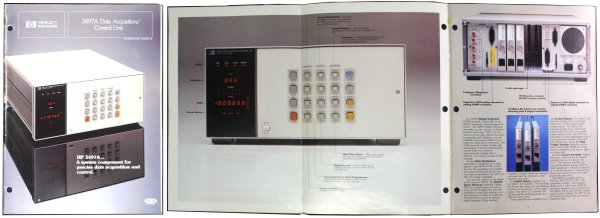
A while later I obtained that particular booklet from that seller anyway. Wasn't too difficult to bypass their silly block. The booklet is very nice, contains lots of useful information, and goes on my 'to scan asap' queue.
It's just 25 pages, cost about US $60 all up including shipping, but totally worth it. One more small piece of history rescued from the clutches of The Stupid.